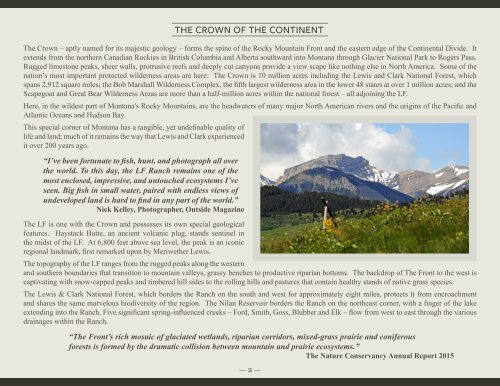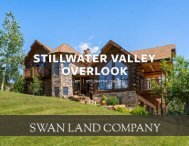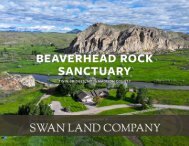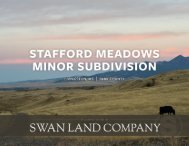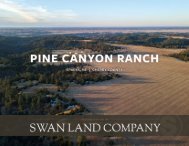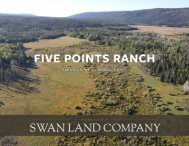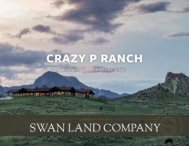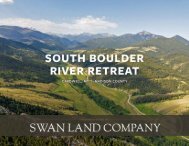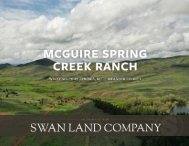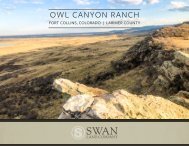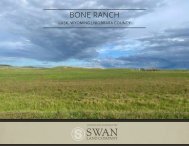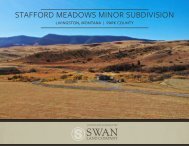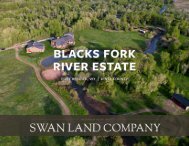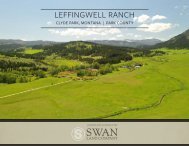You also want an ePaper? Increase the reach of your titles
YUMPU automatically turns print PDFs into web optimized ePapers that Google loves.
THE CROWN OF THE CONTINENT<br />
The Crown – aptly named for its majestic geology – forms the spine of the Rocky Mountain Front and the eastern edge of the Continental Divide. It<br />
extends from the northern Canadian Rockies in British Columbia and Alberta southward into Montana through Glacier National Park to Rogers Pass.<br />
Rugged limestone peaks, sheer walls, protrusive reefs and deeply cut canyons provide a view scape like nothing else in North America. Some of the<br />
nation’s most important protected wilderness areas are here: The Crown is 10 million acres including the Lewis and Clark National Forest, which<br />
spans 2,912 square miles; the Bob Marshall Wilderness Complex, the fifth largest wilderness area in the lower 48 states at over 1 million acres; and the<br />
Scapegoat and Great Bear Wilderness Areas are more than a half-million acres within the national forest – all adjoining the <strong>LF</strong>.<br />
Here, in the wildest part of Montana's Rocky Mountains, are the headwaters of many major North American rivers and the origins of the Pacific and<br />
Atlantic Oceans and Hudson Bay.<br />
This special corner of Montana has a tangible, yet undefinable quality of<br />
life and land; much of it remains the way that Lewis and Clark experienced<br />
it over 200 years ago.<br />
“I’ve been fortunate to fish, hunt, and photograph all over<br />
the world. To this day, the <strong>LF</strong> <strong>Ranch</strong> remains one of the<br />
most enclosed, impressive, and untouched ecosystems I’ve<br />
seen. Big fish in small water, paired with endless views of<br />
undeveloped land is hard to find in any part of the world.”<br />
Nick Kelley, Photographer, Outside Magazine<br />
The <strong>LF</strong> is one with the Crown and possesses its own special geological<br />
features. Haystack Butte, an ancient volcanic plug, stands sentinel in<br />
the midst of the <strong>LF</strong>. At 6,800 feet above sea level, the peak is an iconic<br />
regional landmark, first remarked upon by Meriwether Lewis.<br />
The topography of the <strong>LF</strong> ranges from the rugged peaks along the western<br />
and southern boundaries that transition to mountain valleys, grassy benches to productive riparian bottoms. The backdrop of The Front to the west is<br />
captivating with snow-capped peaks and timbered hill sides to the rolling hills and pastures that contain healthy stands of native grass species.<br />
The Lewis & Clark National Forest, which borders the <strong>Ranch</strong> on the south and west for approximately eight miles, protects it from encroachment<br />
and shares the same marvelous biodiversity of the region. The Nilan Reservoir borders the <strong>Ranch</strong> on the northeast corner, with a finger of the lake<br />
extending into the <strong>Ranch</strong>. Five significant spring-influenced creeks – Ford, Smith, Goss, Blubber and Elk – flow from west to east through the various<br />
drainages within the <strong>Ranch</strong>.<br />
“The Front’s rich mosaic of glaciated wetlands, riparian corridors, mixed-grass prairie and coniferous<br />
forests is formed by the dramatic collision between mountain and prairie ecosystems.”<br />
The Nature Conservancy Annual Report 2015<br />
— 2 —


